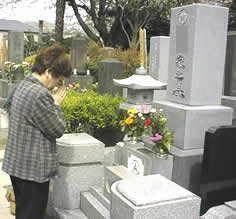* * * * *
The World Haiku Club
WHC World Kigo Database |
Autumn Equinox (aki higan, Japan)
ooooooooooooooooooooooooooooooooooooooooooooooooooooooooooooooooooooooooooooooooooo
|
Location: Japan, other countries Season: Mid-autumn Category: Seasons |
|
Explanation:
This season comprizes
some kigo for mid-autumn. O-higan お彼岸 is a special
time, rooted in Buddhist tradition, when families remember and tend to their
loved ones who have passed away. It is said that when a person dies, they
cross the river of the netherworld,
“Sanzu no kawa” from “Shigan” (this world) to “Higan”
(the other side of the river or other world); families hold memorials
for their relatives living across the river. During this week, families visit
cemetaries to clean and maintain graves. They also pray for their loved ones,
burn incense and offer them flowers and food. The spirits are known to prefer
round food, so botamochi (round glutinous rice balls covered in bean
paste) are eaten on this day. The treat gets its name from botan,
Chinese peonies which bloom in the spring time. As spring and
fall approach, people often say “Atsusa samusa mo Higan made,” This
expression refers to the favorable seasonal changes that occur at the time of
the biannual equinoxes. “Heat and cold last until Higan.” So, we can all look
forward to this time of change, and soon welcome spring and its bounty. http://www.yoke.city.yokohama.jp/echo/0403/c.html
Look at the tradition of visiting the family graves, cleaning them and pooring water over the stones. On this link there are more photos about the proper visit of a grave. 1 First clean the stone. 2 Next remove the old incense sticks. 3 Offer some flowers. 4 Burn some fresh incense sticks. 5 Say your prayers with folded hands.
http://www.zenbutu.com/abouthigan/higansouzi6.jpg http://www.zenbutu.com/abouthigan/ohiganhaka.htm
oooooooooooooooooooooooooooooooooooooooooooooooooooooooooooooooooo Worldwide
use: oooooooooooooooooooooooooooooooooooooooooooooooooooooooooooooooooo Things
found on the way: LINK
of National Holidays in Japan http://www.japan-guide.com/e/e2062.html |
|
Haiku: 《きらきらと秋の彼岸の椿かな 木導》 kirakira
to aki no higan no tsubaki kana
Kidoo shining bright the camellias at the autumn equinox http://www.agara.co.jp/column/mizu/2003-09/mizu030923.html
Autumn equinox Isabelle
Prondzynski |
|
Related
words:
Vernal equinox shunbun
no hi春分の日: kigo for
spring The customs of eating round dumplings and related words are all kigo for spring. *Vernal Equinox Day (Spring Equinox - March 20 in 2004) Originally a traditional Buddhist holiday, this day is set aside to appreciate nature and show love for all living things. http://www.jaist.ac.jp/misc/cosmos/sep95/holidays.html Spider
Lilies, Higan-bana > Spider
Lilies (higanbana) |
To
be continued here:
http://worldkigodatabase.blogspot.com/
ooooooooooooooooooooooooooooooooooooooooooooooooooooooooooooooooooooooooooooooooooo
Please send your
comments and contributions to
Gabi Greve
To the WHC World Kigo Database
http://worldkigodatabase.blogspot.com/ To the WHCworldkigo Discussion Forum http://groups.yahoo.com/group/WHCworldkigo/ To the World Haiku Club http://www.worldhaikuclub.org/ |


